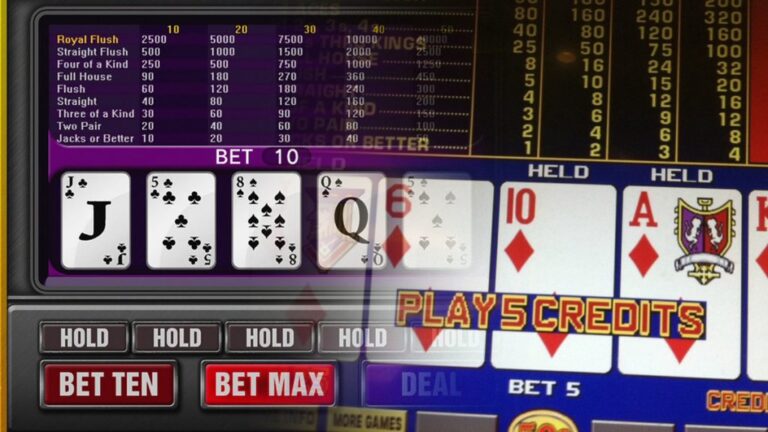If you really want to master video poker and stand a chance at winning against the casinos, you’re probably going to have to practice using some kind of video poker tutorial software.
The history of these kinds of programs is interesting, and I’ve done some research into the subject.
What Does Video Poker Tutoring Software Do?
According to Bob Dancer in Million Dollar Video Poker, video poker tutorial software should be able to do the following:
- Calculate the payback percentage for a specific pay table. When you input a video poker pay table into the software, it should be able to tell you what the payback percentage is for that game if you play with perfect strategy.
- Calculate the appropriate moves for any five-card hand possible on that pay table. This is the most obvious use for a video poker tutoring software package.
- Generate a video poker strategy table for any given game and pay table. A video poker strategy is a list of hands in order of which cards you should hold. I’ll explain more about that later in this post.
- Correct your decisions as you practice. In other words, you should be able to input a game and a pay table and play that game in the software. And the game should notify you when you’re making a strategy mistake.
Such a program seems like it would be relatively easy to put together in the 21st century, but when such software first became available, it was a huge achievement.
Some Explanations of Video Poker Pay Tables and Strategy Charts
If you only have passing familiarity with video poker, you should understand a couple of things about the pay tables and the strategy charts for the games.
What makes video poker superior to slot machines is that ability to understand both the probability of achieving each outcome and the payout for each outcome. With a slot machine, you only know what the payout is for each outcome. You have no way of determining the probability of those outcomes because that information is hidden inside the random number generator.

But a real money video poker game uses the same probabilities you’d find with a deck of 52 cards, so we can determine the odds of various outcomes for various decisions. A video poker strategy chart uses this information to create a prioritized list of which hands you should hold onto and which cards you should discard.
The top hand on any video poker strategy chart, obviously, is the royal flush. If you’re dealt a royal flush, you would obviously hold all five of those cards and collect your jackpot. If you’re playing Jacks or Better, you’ll usually hold onto any paying combination. The only exceptions are that you would break a flush or a straight if you had a draw to a straight flush.
Note:
Sometimes, this will mean holding on to a pair and discarding the other three cards to try to improve to a three of a kind, four of a kind, or full house. To use the video poker strategy table, you just start at the top and go down the list until you get to the highest ranked cards on that list. Those are the cards you hold.
If the video poker strategy chart is detailed enough, you’ll achieve the payback percentage calculated for the game. Any deviations from that strategy will result in a lower payback percentage than the one calculated.
VP Exact From Stanford Wong
One of the earliest video poker software programs was VP Exact from Stanford Wong (who’s better known for writing about blackjack). The only function that VP Exact performed was the first function on the earlier list. You could input a pay table and VP Exact would tell you what payback percentage you could achieve if you played that game perfectly.
Note:
This program was released in 1990, and it was cumbersome. For example, you might input the pay table for a 9/6 Jacks or Better game, and VP Exact would spend six hours calculating the expected return for the game, which is 99.5439%.
Most anyone who’s read anything on the internet about Jacks or Better video poker already knows that the payback percentage for the game is 99.54%. But 30 years ago, it was a different gambling world.
VP Exact, at the time, seemed revolutionary.
Video Poker Analyzer and Stanford Wong Video Poker
Wong didn’t quit with VP Exact, though. He later produced more software, originally called Video Poker Analyzer but later called it Stanford Wong Video Poker.

The two software would give you the appropriate strategy for any five-card hand that you might input. They would also allow you to play practice hands and correct you when you made mistakes. Combining this software with Wong’s earlier software made for a potent one-two punch for video poker players.
Note:
In the early 1990s, these programs were the best available, even though they had odd flaws. For example, you could only program flush and straights in Deuces Wild to return the same amount.
But being able to practice without risking any money and getting corrected as you made mistakes was a big leap forward for fans of real money video poker.
Video Poker Tutor
Video poker software advanced relatively quickly. By 1993, Gary Catlin had programmed another video poker software called Video Poker Tutor. It had all the functions of VP Exact and Stanford Wong Video Poker in the same package. On top of that, it was much faster. You could get the expected return for a pay table in Video Poker Tutor in 20 minutes instead of six hours, for example.
Bob Dancer used Video Poker Tutor to create his original set of video poker reports, the ones that later became his “Winners Guide” series. He also used the software when he was teaching his video poker classes.
Video Poker Tutor is, of course, obsolete today for multiple reasons. The main reason is that better and faster software now exists. But also, Video Poker Tutor worked on DOS. Most of the readers of this blog probably don’t remember what DOS is, but suffice it to say that it was the most common operating system on computers before the launch of Windows.
WinPoker U and Bob Dancer Presents WinPoker
The next video poker tutorial software was WinPoker U, programmed by Dean Zamzow in 1996. It had all the same functionality as Video Poker Tutor, but it was faster. It also offered some new features that hadn’t been available with the earlier software. TomSki and Bob Dancer teamed up to create improvements to WinPoker U and created a marketing plan. For years, WinPoker U was the best-selling video poker tutorial software available.
But it did make a slight change to its name when TomSki and Dancer got involved. It became “Bob Dancer Presents WinPoker.” Since Dancer had a brand name in the gambling space, this was a good marketing move.
Note:
Also, his improvements and TomSki’s improvements sped up the program even more. It no longer took the computer 20 minutes to come up with a payback percentage for a specific pay table; it only took about 60 seconds.
By 1998, they were selling thousands of copies of the software via ads in Casino Player and Strictly Slots magazines.
Video Poker Strategy Master
By 1999, TomSki had programmed a new video poker tutorial software called Video Poker Strategy Master. This one would generate a nearly perfect strategy card for any video poker pay table you fed into it.

There was a plan, at one time, to merge Video Poker Strategy Master with WinPoker, but for whatever reason, it never happened.
Until this point, I’ve relied on Bob Dancer’s Million Dollar Video Poker for information about the history of video poker tutorial software. From here on out, I’ve done the research for the rest of the history on various websites.
Video Poker for Winners
Eventually, the Bob Dancer video poker programs culminated in a program called Video Poker for Winners, which is still available at Dancer’s website for about $50. It has limited functionality now compared to its past iterations, though, as it relied on Adobe Flash for its playable game tutorial graphics.
Note:
Flash has been discontinued. It’s unclear if Dancer has plans to come up with a new version, although Video Poker for Winners is still useful.
Frugal Video Poker and Wolf Video Poker
Jim Wolf programmed another video poker tutorial software that was combined with a newer video poker brand for marketing purposes—Frugal Video Poker. Jean Scott wrote multiple books in her “Frugal Gambler” series, most of which focused on combining video poker games with rewards programs to get the most value from your vacations.
Combining that brand with tutorial software made a lot of sense, and Frugal Video Poker is an older software now but still useful and available. The best thing about Frugal Video Poker is that it’s now available for free. It has all the functions that Dancer suggests a video poker tutorial software should have.
One of the reasons Frugal Video Poker is now available for free is because a newer version called Wolf Video Poker has become available for a price.
Web-Based Video Poker Tutorial Software
Of course, all the video poker tutorial software programs discussed in this post are old. The newest is Wolf Video Poker, which is now over 10 years old.

You can probably find web-based video poker tutorial software that you can run right out of your browser these days. I know that at least some of the functionality of these older software packages— especially the calculation of the expected returns—are available online for free at multiple websites.
Conclusion
You’ll probably eventually be able to do everything you needed a video poker tutorial software for on your smartphone. But it’s fun to look back at and think about how the history of such software developed over time.











